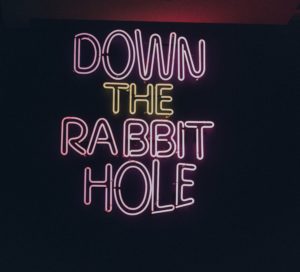
A neon sign that says ” down the rabbit hole”
Down the rabbit hole again….
So, it happened, again. I set out once more to find just a couple of articles on a topic I was considering for an upcoming assignment, determined that I would be focused and efficient. Then, I fell into the rabbit hole; in the words of Robert Frost ,“way leads on to way/I doubted if I should ever come back”. But come back I did, with a slew of interesting articles. My purpose here is to use this post to disentangle and make sense of some of the research found, aspiring to simultaneously uncover a focus and direction.
Resource #1
Guiding Principles for Collaborative Learning. This government webpage outlines the who, why and what of collaborative learning. As cited in this document, collaborative learning is defined by Smith and MacGregor (1992) as:
“Collaborative learning” is an umbrella term for a variety of educational approaches involving joint intellectual effort by students, or students and teachers together. Usually, students are working in groups of two or more, mutually searching for understanding, solutions, or meanings, or creating a product. Collaborative learning activities vary widely, but most center on students’ exploration or application of the course material, not simply the teacher’s presentation or explication of it” (p. 1)
Some of the key connected theorists mentioned within this document are Dewey, Vygotsky, Bruner, Bloom and Slavin.
Resource #2
From Knowledge to Wisdom: Critical evaluation in New Literacy Instruction
This 2012 article, by Phil Nichols, I found interesting as it discusses the use of technology in the classroom. It draws on the idea that often technology is used just for the sake of using it and thus lacks purpose. Nichols includes ideas on how to use technology purposefully, in ways that will create transferable skills. This article may help with creating ideas on how to use technology with purpose within collaborative online spaces.
Resource #3
Moving beyond the predictable failure of Ed-Tech initiatives
(2020) looked at the implementation of Ed Tech initiatives, “arguing against a reductionist notion of ‘technology’ and its perverse effects on education” (p. 71) . They go on to say that, this, “disregards the complex fabric of technology” (p. 71). Technology and it’s uses, now more than ever, should be included thoughtfully. This article outlines some of the specific issues, illuminating some considerations that should be taken when including technology.
Resource #4
Morawski, M and Budke, A (2019) found, as one of the results of their study, that peer feedback is accurate, which “suggests that one could hand over more responsibility in terms of feedback to the students” ( p.21). This finding and the study are interesting in that they investigate assessment strategies, technology and collaboration.
Resource#5
“To Be, or Not to Be”: Modernizing Shakespeare With Multimodal Learning Stations
As an English teacher who loves Shakespeare, I was interested in this 2019 article by Harvey M,. Deuel, A. & Marlatt, R. as it looked at using technology to make Shakespeare more accessible to students. It would be interesting to take some of these ideas and look at how they could be applied in an online environment.
Resource #6
This 2020 review by Lammert, C. is interesting in that it looks at literacy and examines the use of collaboration, a natural part of Inquiry. It includes many connections to the theories of Dewey.
Resource #7
Writing on Social Media: a Review of Research in the High School Classroom
This 2020 review by Galvin, S., and Greenhow, C, connects to both collaboration and technology. Oh, did I mention this was the area I was looking for research in? The review includes technology that could be used collaboratively in the online environment. Some of the examples shared as part of the review are blogs, storyboard, collaborative writing, wiki’s, forum’s, Google +, closed Facebook groups and Edmodo (to name a few). The positives as well as concerns connected to the implementation and use of social media are discussed.
Resource #8
Rhizomatic Education: Community as Curriculum
This blog post, by Dave, contains the contents of a previously published paper that discusses learning and curriculum as a metaphor; the rhizome.
“In the rhizomatic view, knowledge can only be negotiated, and the contextual, collaborative learning experience shared by constructivist and connectivist pedagogies is a social as well as a personal knowledge-creation process with mutable goals and constantly negotiated premises”.
Dave explores concepts within this metaphor connected to knowledge and education. There are many connections to both technology and collaboration/social learning.
Resource #9
Chapter 12 from How We Teach Now: The GSTA Guide to Student-Centered Teaching
Chapter 12: Cooperative and Collaborative Learning: Getting the Best of Both Words
This chapter, by Sawyer,J., and Obeiddiscusses, R. discusses the benefits and uses of cooperative learning and collaboration (inquiry, project based learning) and includes examples of their uses in collaborative oral presentations, literature analysis and video discussions.
Resource #10
Nahachewsky, J. & Slomp, D. (2009). Sound and Fury: Studied response(s) of curriculum and classroom in digital times.
This final article, one of the readings for this week, also includes connections that can be used to consider the use of technology for collaboration.
While creating this post and reading through these articles, I began to see many interconnected points. Collaboration, a key strategy considered within B.C’s curriculum contains within it and through its uses, a means to provide student centred learning/ personalization, community building/ social learning, and can link to purposeful uses of technology. I believe I have, after all, uncovered a focus and direction.
“Onward and Upward”
– C. S Lewis
Photo by Haley Lawrence on Unsplash